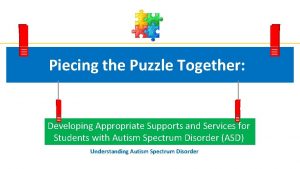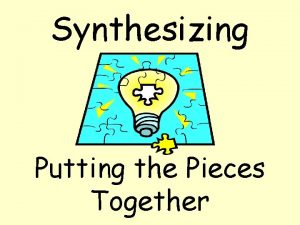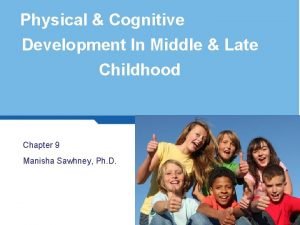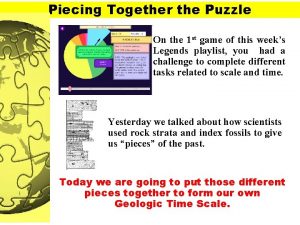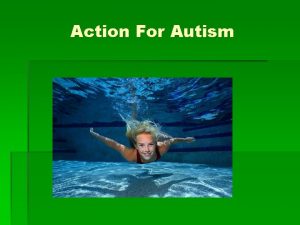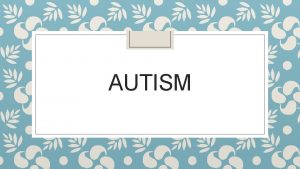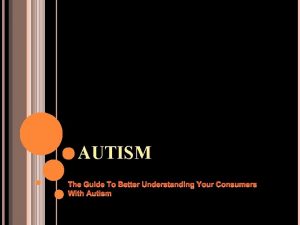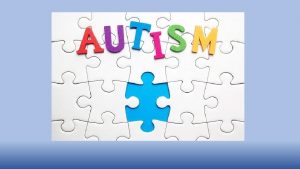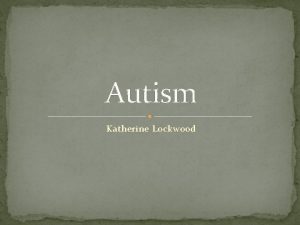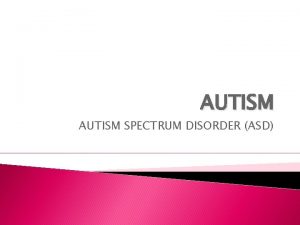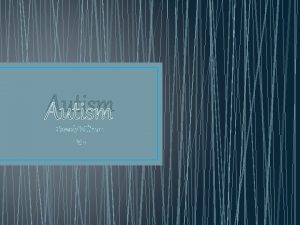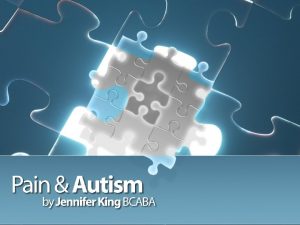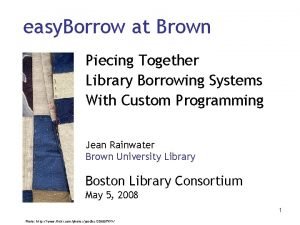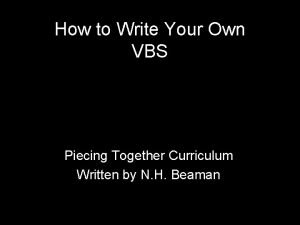PIECING TOGETHER THE PUZZLE OF AUTISM Professional Development





















- Slides: 21

PIECING TOGETHER THE PUZZLE OF AUTISM Professional Development

OBJECTIVES: INTASC Standard: Standard #9: Professional Learning and Ethical Practice The teacher engages in ongoing professional learning and uses evidence to continually evaluate his/her practice, particularly the effects of his/her choices and actions on others (learners, families, other professionals, and the community), and adapts practice to meet the needs of each learner. Objectives: Individuals in the elementary school faculty will be able to describe the common characteristics of an individual with Autism Individuals in the elementary school faculty will be able to apply three strategies to the classroom when working with an individual with Autism Individuals in the elementary school faculty will be able to develop a task analysis for a student with autism enabling them to participate in the general education classroom

https: //www. youtube. com/watch ? v=Sj. Qcx. ATh 1 v. I

WHAT IS AUTISM SPECTRUM DISORDER? ASD is a developmental disorder that impacts the way individuals communicate and interpret their environment, often resulting in challenges with social interactions and processing information.

TYPICAL CHARACTERISTICS Persistent deficits in social communication/social interaction Restricted, repetitive patterns of behavior, interests, or activities Symptoms present in early developmental period Symptoms cause impairment in social or occupational areas of functioning Disturbances not better explained by ID Approximately 5% of all students with disabilities have ASD Four times as many boys as girls have ASD Half spend more than 40% of their time in general education classes

WHAT DOES AUTISM LOOK LIKE? https: //www. youtube. com/watch ? v=AUtj. Zx. PFVv 4

WHAT INDIVIDUALS WITH ASD WANT YOU TO KNOW… https: //www. youtube. com/wa tch? v=x 5 m 5 vqr. FZpc

HOW CAN I MAKE MY CLASSROOM ACCESSIBLE It’s your turn… Using what you know about the typical behaviors of a student with autism, work in small groups to discuss how these behaviors will affect the classroom community.

Now using your list try to think of 3 ways you can help your student access the general education curriculum.

EVIDENCE BASED PRACTICES: APPLIED BEHAVIOR ANALYSIS Applied Behavioral Analysis Both adaptive and maladaptive behavior is learned Learning occurs as a result of the consequences of behavior Stimuli are defined by the effects on behavior Behavior is described in observable and measurable terms Refer to ABA Handout

EVIDENCE BASED PRACTICES Behavioral Issues Aggression Self-injury Self-stimulation Social maladaptive behavior Property destruction Withdrawal Oppositional behavior Stereotyped behavior Evidence Based Approach: Incidental Teaching (Mc. Gee) Hall, L. (2009). Page 92

EVIDENCE BASED PRACTICES Incidental Teaching Approach This approach is used to increase the skills of individuals with ASD. It is used to help the individual and in return give them access to a desired material or activity. The educator begins by requesting their desired behavior or skill. And continues by following the Wait-Ask-Say-Show-Do model (least to most sequence) Wait – take the child to the area where environmental cues will be evident. If there is no response within 5 seconds… Ask – ask the childe a generic question, such as “ What do you need to do? ” Following 5 seconds of no response… Say – say what is expected in the from of a simple direction. A gesture may then be used to… Show – direct the child’s attention to the object or materials. If the direction is not followed… Do – use gentle, physical guidance to help the child complete the task When the task has been completed by the child, give them access the material or activity

EVIDENCE BASED PRACTICES Social Skills Defecits Reciprocity and Negotiating Joint Attention Shared focus of two people on an object Pragmatics The social use of language Leisure Skills Solitude Evidence Based Approach: The DIR/Floortime Approach (Greenspan) Hall, L. (2009). Pages 128 -130

EVIDENCE BASED PRACTICES The DIR/Floortime Approach Uses the individual's natural emotions and interests to enhance the functional emotional capacities of joint attention, engagement, two-way problem solving, and symbolic thought. Five-step approach 1. Listen and watch the student 2. Respond to the student with words and gestures that are appropriate in the situation 3. Follow the student’s lead 4. Extend or expand the language or play 5. Allow the student to initiate closure of the activity

EVIDENCE BASED PRACTICES Communication Difficulties Receptive/expressive language Language rhythm, pitch, inflection and volume Body language Facial affect Interpretation of non-verbal behavior of others Concrete and literal thinking Evidence Based Approach: Verbal Behavior Approach (Skinner) Hall, L. (2009). Pages 175 -177

EVIDENCE BASED PRACTICES Verbal Behavior Approach Individuals become listeners when they respond to the vocal, verbal speech of others, and they become speakers when they use various forms (signs, pictures, vocalizations) to convey their feelings, affect others’ behaviors, and change their own circumstances. Approach Begin by teaching students to request or “mand” activities and to make choices Physical prompts can be used until the student can make the request on their own Teach the student to label or “tact” items Teach the student to imitate vocal language or participate in “echoics” Teach the student to respond to questions by others or “intraverbals”

EVIDENCE BASED PRACTICES Now take out your approaches from before. Read them over. Do any of them mirror some of the approaches we have discussed so far? Do you think they fall into the dynamics of ABA? Here’s your homework… Go home tonight and research your approaches and try to find evidence that may support your ideas Choose your favorite approach (whether it is one of yours, mine, or a new one you find) and become very familiar with it ADD IT TO YOUR TOOLBOX!

TASK ANALYSIS A task analysis is used to break complex tasks into a sequence of smaller steps or actions. For some individuals on the autism spectrum, even simple tasks can present complex challenges. Having an understanding of all the steps involved for a particular task can assist in identifying any steps that may need extra instruction and will help teach the task in a logical progression. Depending on the needs of the child a task analysis may need to be extremely specific in it steps or can be more broad. ex. 1) Dry hands vs. paper garbage 1) pick up paper towel 2) rub hands together against towel 3) throw paper towel in

EXAMPLE:

NOW ITS YOUR TURN! See Task Analysis Challenge handout

THANK YOU FOR YOU TIME Please refer to the resources page for more information. Don’t forget to continue your own research after all… “Knowledge is power” –Francis Bacon
 Examples of functional limitations
Examples of functional limitations Summarizing vs synthesizing
Summarizing vs synthesizing Late childhood physical development
Late childhood physical development What fires together wires together
What fires together wires together Hình ảnh bộ gõ cơ thể búng tay
Hình ảnh bộ gõ cơ thể búng tay Frameset trong html5
Frameset trong html5 Bổ thể
Bổ thể Tỉ lệ cơ thể trẻ em
Tỉ lệ cơ thể trẻ em Voi kéo gỗ như thế nào
Voi kéo gỗ như thế nào Glasgow thang điểm
Glasgow thang điểm Hát lên người ơi
Hát lên người ơi Các môn thể thao bắt đầu bằng tiếng đua
Các môn thể thao bắt đầu bằng tiếng đua Thế nào là hệ số cao nhất
Thế nào là hệ số cao nhất Các châu lục và đại dương trên thế giới
Các châu lục và đại dương trên thế giới Cong thức tính động năng
Cong thức tính động năng Trời xanh đây là của chúng ta thể thơ
Trời xanh đây là của chúng ta thể thơ Mật thư tọa độ 5x5
Mật thư tọa độ 5x5 101012 bằng
101012 bằng Phản ứng thế ankan
Phản ứng thế ankan Các châu lục và đại dương trên thế giới
Các châu lục và đại dương trên thế giới Thơ thất ngôn tứ tuyệt đường luật
Thơ thất ngôn tứ tuyệt đường luật Quá trình desamine hóa có thể tạo ra
Quá trình desamine hóa có thể tạo ra
